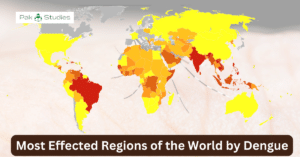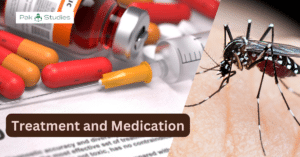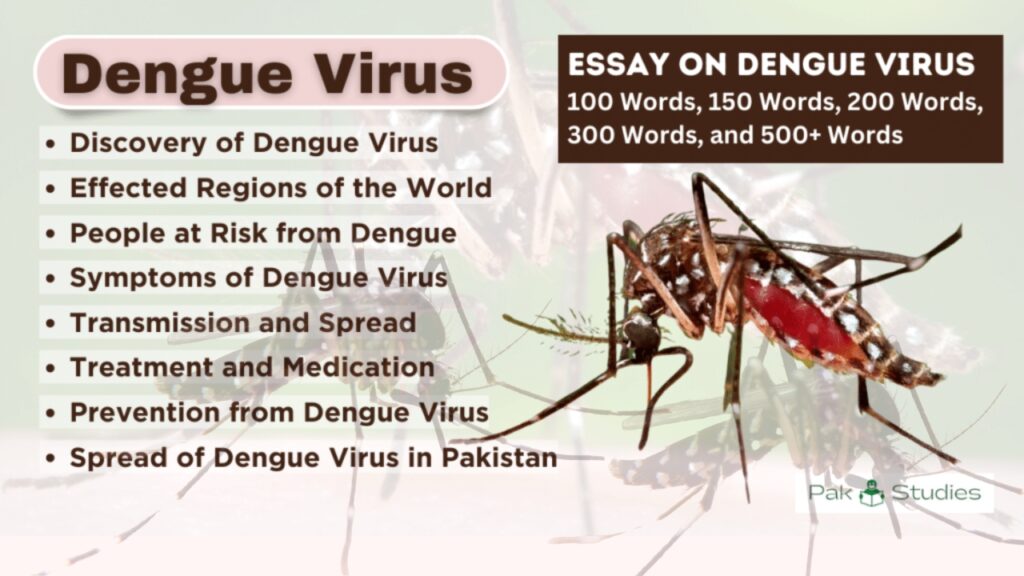100 Words Essay on Dengue Virus
Dengue is a mosquito-borne viral infection. It is caused by the dengue virus, which belongs to the Flaviviridae family. Dengue is primarily transmitted to humans through the bites of infected Aedes mosquitoes, particularly Aedes aegypti.
These mosquitoes are most active during the day and typically breed in standing water. The symptoms of dengue can vary from mild to severe, and in some cases, it can be life-threatening. There is no specific antiviral treatment for dengue.
Management of the infection involves supportive care to alleviate symptoms and prevent complications. Prevention of dengue primarily focuses on controlling mosquito populations and minimizing exposure to mosquito bites.
150 Words Essay on Dengue Virus
Dengue is a mosquito-borne viral infection. It is caused by the dengue virus, which belongs to the Flaviviridae family. Dengue is primarily transmitted to humans through the bites of infected Aedes mosquitoes, particularly Aedes aegypti. These mosquitoes are most active during the day and typically breed in standing water. Dengue is not directly transmitted from person to person, except in rare cases of vertical transmission through blood transfusions etc.
The symptoms of dengue can vary from mild to severe, and in some cases, it can be life-threatening. The most common symptoms include high fever, severe headache, pain behind the eyes, joint and muscle pain, rash, and mild bleeding (such as nose or gum bleeding).
There is no specific antiviral treatment for dengue. Management of the infection involves supportive care to alleviate symptoms and prevent complications. Prevention of dengue primarily focuses on controlling mosquito populations and minimizing exposure to mosquito bites.
200 Words Essay on Dengue Virus
Dengue is a mosquito-borne viral infection. It is caused by the dengue virus, which belongs to the Flaviviridae family. Dengue is primarily transmitted to humans through the bites of infected Aedes mosquitoes, particularly Aedes aegypti. These mosquitoes are most active during the day and typically breed in standing water.
The dengue virus was first discovered in the 1940s during outbreaks of a disease called “breakbone fever” in the Philippines and Thailand.
Dengue is not directly transmitted from person to person, except in rare cases of vertical transmission through blood transfusions, etc. The symptoms of dengue can vary from mild to severe, and in some cases, it can be life-threatening.
The most common symptoms include high fever, severe headache, pain behind the eyes, joint and muscle pain, rash, and mild bleeding (such as nose or gum bleeding). Severe forms of dengue, known as dengue hemorrhagic fever (DHF) and dengue shock syndrome (DSS), can cause bleeding, organ failure, and potentially death.
There is no specific antiviral treatment for dengue. Management of the infection involves supportive care to alleviate symptoms and prevent complications. It is essential to rest, maintain fluid intake, and take medications. Prevention of dengue primarily focuses on controlling mosquito populations and minimizing exposure to mosquito bites.
300 Words Essay on Dengue Virus
Dengue is a mosquito-borne viral infection that is widespread in tropical and subtropical regions of the world. It is caused by the dengue virus, which belongs to the Flaviviridae family. There are four different serotypes of the virus: DEN-1, DEN-2, DEN-3, and DEN-4.
In 1943, a Philippine physician named Albert Sabin isolated the dengue virus and described it as the cause of the disease. Around the same time, American researcher Max Theiler, demonstrated that dengue could be transmitted to laboratory animals.
Dengue is primarily transmitted to humans through the bites of infected Aedes mosquitoes, particularly Aedes aegypti. These mosquitoes are most active during the day and typically breed in standing water found in and around human habitations. Dengue is not directly transmitted from person to person, except in rare cases of vertical transmission from a pregnant woman to her fetus or through blood transfusions.
The symptoms of dengue can vary from mild to severe, and in some cases, it can be life-threatening. The most common symptoms include high fever, severe headache, pain behind the eyes, joint and muscle pain, rash, and mild bleeding (such as nose or gum bleeding). Severe forms of dengue, known as dengue hemorrhagic fever (DHF) and dengue shock syndrome (DSS), can cause bleeding, organ failure, and potentially death.
There is no specific antiviral treatment for dengue. Management of the infection involves supportive care to alleviate symptoms and prevent complications. It is essential to rest, maintain fluid intake, and take medications like acetaminophen to reduce fever and relieve pain. However, drugs like aspirin or non-steroidal anti-inflammatory drugs (NSAIDs) should be avoided, as they can increase the risk of bleeding.
Prevention of dengue primarily focuses on controlling mosquito populations and minimizing exposure to mosquito bites. This can be achieved by eliminating mosquito breeding sites, using mosquito repellents, wearing protective clothing, and using bed nets.
500 to 1000 Essay on Dengue Virus
What is Dengue Virus?
Dengue is a mosquito-borne viral infection that is widespread in tropical and subtropical regions of the world. It is caused by the dengue virus, which belongs to the Flaviviridae family. So far four different serotypes of the virus have been identified: DEN-1, DEN-2, DEN-3, and DEN-4.
Discovery of Dengue Virus
The dengue virus was first discovered in the 1940s during outbreaks of a disease called “breakbone fever” in the Philippines and Thailand. The credit for its discovery goes to various scientists who made important contributions.
In 1943, a Philippine physician named Albert Sabin isolated the dengue virus and described it as the cause of the disease. Around the same time, American researcher Max Theiler, who would later receive the Nobel Prize in Physiology or Medicine for his work on yellow fever, demonstrated that dengue could be transmitted to laboratory animals.
Since its discovery, dengue has become a significant global health concern, particularly in tropical and subtropical regions. It has spread to numerous countries, resulting in large outbreaks and posing challenges for public health authorities. Extensive research has been conducted to understand the virus, develop diagnostic tests, and explore potential treatments and vaccines.
Most Affected Regions of the World from Dengue Virus
The regions of the world that are most affected by dengue are Southeast Asia and the Western Pacific. These regions have a high burden of dengue cases and experience frequent outbreaks.
Within Southeast Asia, countries such as Indonesia, Thailand, Vietnam, the Philippines, and Malaysia have reported a significant number of dengue cases. In the Western Pacific, countries like Cambodia, Laos, Papua New Guinea, and the Pacific Island nations have also been heavily affected.

It is worth noting that dengue is endemic in many other parts of the world as well. In the Americas, countries in Central and South America, as well as the Caribbean, have seen substantial dengue transmission. Brazil, Mexico, Colombia, and Puerto Rico have reported a high number of cases.
In Africa, dengue is less commonly reported compared to other mosquito-borne diseases like malaria, but outbreaks have been documented in countries such as Cape Verde and Sudan. Additionally, dengue has also been reported in parts of the Eastern Mediterranean and Southeast Asia.
The distribution and impact of dengue can vary from year to year, and outbreaks can occur in areas where the virus is not traditionally endemic. Factors such as climate, urbanization, travel, and population movement can influence the spread and intensity of dengue outbreaks in different regions.
People at Risk by Dengue Virus Infection
Dengue is a significant public health concern, and its impact can vary from year to year and by geographical location. According to the WHO (World Heath Organization), around 3.9 billion people are at risk of dengue infection worldwide.
Each year, there are an estimated 100-400 million dengue infections globally. Of these, approximately 500,000 cases develop into severe dengue, which can be life-threatening. The majority of severe dengue cases occur in children.
Dengue is endemic in more than 100 countries, primarily in tropical and subtropical regions of Asia, the Pacific, the Americas, Africa, and the Caribbean. The burden of dengue is particularly high in Southeast Asian and Western Pacific countries, where epidemics occur regularly.
It is important to note that dengue incidence can vary significantly from year to year and between regions. Outbreaks and epidemics can occur, especially in areas with high mosquito populations and inadequate vector control measures. Efforts to prevent and control dengue continue to be essential to reduce its impact on public health.
Transmission and Spread of Dengue Virus

Dengue is primarily transmitted to humans through the bites of infected Aedes mosquitoes, particularly Aedes aegypti. These mosquitoes are most active during the day and typically breed in standing water found in and around human habitations. Dengue is not directly transmitted from person to person, except in rare cases of vertical transmission from a pregnant woman to her fetus or through blood transfusions.
Symptoms of Dengue Virus
The symptoms of dengue can vary from mild to severe, and in some cases, it can be life-threatening. The most common symptoms include high fever, severe headache, pain behind the eyes, joint and muscle pain, rash, and mild bleeding (such as nose or gum bleeding). Severe forms of dengue, known as dengue hemorrhagic fever (DHF) and dengue shock syndrome (DSS), can cause bleeding, organ failure, and potentially death.
Treatment and Medication of Dengue Virus
Despite thorough research, scientists are failed to find the specific antiviral treatment for dengue. Management of the infection involves supportive care to alleviate symptoms and prevent complications. It is essential to rest, maintain fluid intake, and take medications like acetaminophen to reduce fever and relieve pain. However, drugs like aspirin or non-steroidal anti-inflammatory drugs (NSAIDs) should be avoided, as they can increase the risk of bleeding.

It is crucial to note that dengue treatment should always be carried out under the guidance of healthcare professionals. The severity of the disease and individual patient factors will determine the appropriate treatment plan.
In terms of ongoing research and development, there have been efforts to develop specific antiviral medications and vaccines for dengue. Several dengue vaccine candidates have been developed, including the Dengvaxia vaccine. However, the use and availability of vaccines may vary depending on the country and its regulatory approvals.
It is important to consult with healthcare professionals and follow the guidelines provided by local health authorities for the most up-to-date information on dengue treatment options in specific regions.
Prevention from Dengue Virus
Prevention of dengue primarily focuses on controlling mosquito populations and minimizing exposure to mosquito bites. This can be achieved by eliminating mosquito breeding sites, using mosquito repellents, wearing protective clothing, and using bed nets. Dengue vaccines have also been developed and are available in some countries, but their use and availability may vary depending on the region.
Spread of Dengue Virus in Pakistan
Dengue has been a significant public health concern in Pakistan, with periodic outbreaks occurring in different parts of the country. The spread of dengue in Pakistan is primarily attributed to the presence of the Aedes aegypti mosquito, which is the primary vector for dengue transmission. The “Essay on Dengue Virus” is covering general worldwide information about Dengue, Please click for more information about Spread of Dengue Virus in Pakistan.



